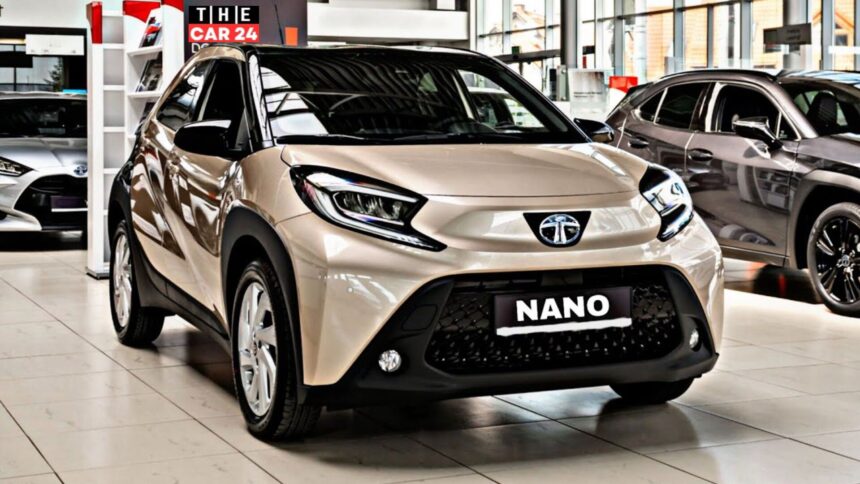Upcoming Tata Nano EV
The Shift to Electric: Why Tata Nano EV?
The global automotive industry is rapidly transitioning towards electric vehicles (EVs), driven by environmental concerns and advancements in technology. Tata Motors has been at the forefront of this movement in India, with a strong commitment to sustainability. The Tata Nano EV is set to combine the brand’s legacy of affordability with the modern necessity for greener transportation. This compact electric car is expected to appeal to urban commuters and environmentally conscious consumers looking for an affordable yet efficient vehicle.
Design and Features of Tata Nano EV
The Tata Nano EV will retain the compact and practical design that made the original Nano popular, while incorporating modern touches to appeal to contemporary tastes.
- Exterior Design: Expect a sleek, aerodynamic shape with a futuristic touch, perhaps with LED lighting and new color options to distinguish it from its predecessor.
- Interior Features: Inside, the Nano EV will likely feature a minimalist design, maximizing space for passengers. Infotainment systems, digital displays, and smart connectivity options are expected to cater to tech-savvy users.
- Technological Advancements: Equipped with advanced battery management systems, regenerative braking, and possibly even autonomous driving features, the Nano EV is designed to be a cutting-edge vehicle in its segment.
Expected Performance and Range
The Tata Nano EV is expected to offer a balanced performance suitable for city driving.
- Battery Capacity and Range: Reports suggest that the Nano EV could come with a battery capacity of around 15-20 kWh, providing a range of approximately 150-200 km on a single charge. This makes it ideal for daily urban commutes.
- Charging Options: Fast-charging capabilities will be a key feature, allowing users to recharge up to 80% of the battery within an hour. Home charging solutions will also be available.
- Performance on Urban Roads: With a compact size and electric drivetrain, the Nano EV is likely to excel in navigating congested city streets, offering a smooth and quiet ride.
Tata Nano EV Variants
Tata Motors is expected to offer multiple variants of the Nano EV to cater to different customer needs. Below is a table outlining the anticipated models and their expected prices:
| Model | Battery Capacity | Range (km) | Expected Price (INR) |
|---|---|---|---|
| Tata Nano EV Basic | 15 kWh | 150 | 4,50,000 |
| Tata Nano EV Mid | 18 kWh | 180 | 5,00,000 |
| Tata Nano EV Premium | 20 kWh | 200 | 5,50,000 |
Price Comparison with Other EVs

The pricing of the Tata Nano EV is expected to be highly competitive, making it one of the most affordable electric vehicles in India. When compared to other compact EVs like the MG ZS EV, Tata Nexon EV, and Mahindra eKUV100, the Nano EV’s price point could make it an attractive option for budget-conscious buyers looking to transition to electric mobility.
Environmental Impact
One of the key benefits of the Tata Nano EV is its reduced carbon footprint. By switching to an electric drivetrain, the Nano EV will contribute significantly to reducing urban pollution. This aligns with global efforts to combat climate change and improve air quality in densely populated areas.
Market Potential and Target Audience
The Tata Nano EV is expected to attract a wide range of customers, particularly urban dwellers and first-time car buyers. Its affordability, compact size, and ease of use make it an ideal choice for city driving. Additionally, its eco-friendly credentials will appeal to environmentally conscious consumers looking to reduce their carbon footprint.
Challenges and Potential Drawbacks
Despite its many advantages, the Tata Nano EV may face some challenges in the market.
- Battery Life and Charging Infrastructure: Concerns about battery longevity and the availability of charging stations could deter potential buyers. However, Tata’s investment in expanding the EV charging network should alleviate these concerns over time.
- Competition: The compact EV market is becoming increasingly crowded, with several automakers launching their own models. Tata Nano EV will need to differentiate itself through pricing, features, and brand loyalty.
Government Support and Incentives
The Indian government has been actively promoting the adoption of electric vehicles through various incentives and subsidies. Buyers of the Tata Nano EV can expect to benefit from tax rebates, reduced registration fees, and other perks that make EVs more affordable.

Future Prospects for Tata Nano EV
Tata Motors has ambitious plans for the Nano EV, including potential expansion into international markets where compact, affordable EVs are in demand. The success of the Nano EV in India could pave the way for similar models tailored to other regions, positioning Tata as a global player in the electric vehicle market.
Customer Expectations and Feedback
As the launch date approaches, anticipation for the Tata Nano EV is building. Early feedback from potential customers suggests a strong interest in the vehicle, particularly among younger buyers and those looking for a second car for city use. Tata Motors is expected to leverage this interest with a targeted marketing campaign.
Tata Nano EV vs. Traditional Nano
While the original Tata Nano was revolutionary in its own right, the Nano EV represents a significant upgrade. Key differences include the switch to an electric drivetrain, improved safety features, and modern design elements. The Nano EV is positioned as a forward-looking vehicle that builds on the legacy of its predecessor while addressing the needs of today’s consumers. (LINK)
Conclusion
The Tata Nano EV is more than just an update to an iconic car; it represents a bold step towards a sustainable future. With its affordable pricing, compact design, and eco-friendly credentials, the Nano EV is set to become a game-changer in urban mobility. As Tata Motors continues to innovate, the Nano EV could very well redefine what it means to drive in India’s bustling cities.
FAQs
- What is the expected launch date of Tata Nano EV?
The Tata Nano EV is expected to launch in late 2024 or early 2025, though an official date has not yet been confirmed. - How much will Tata Nano EV cost?
The Tata Nano EV is expected to be priced between INR 4,50,000 and INR 5,50,000, depending on the variant. - What is the range of Tata Nano EV on a single charge?
The Tata Nano EV is expected to offer a range of 150 to 200 km on a single charge, depending on the battery capacity. - Will Tata Nano EV be available outside India?
While the initial launch is focused on the Indian market, Tata Motors may consider exporting the Nano EV to other regions in the future. - How does Tata Nano EV compare to other electric cars in its segment?
The Tata Nano EV is expected to be one of the most affordable electric cars in its segment, offering competitive features and pricing compared to other compact EVs.
Read more.. Honda Activa 7G
Read more.. 2024 Jeep Compass

